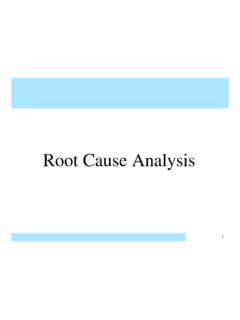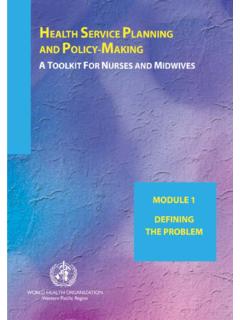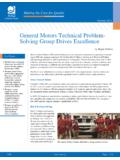Transcription of A Definition of Proactive Problem Management - …
1 A Definition of Proactive Problem Management A paper describing how Problem Management can prevent service impacting issues An itSMF UK White Paper, January 2013 Copyright 2013, itSMF UK A Definition of Proactive Problem Management 2 Copyright 2013, itSMF UK CONTENTS Executive Summary .. 4 Introduction .. 5 Purpose of this 5 Objective of this Paper .. 5 Method .. 5 General Description .. 6 Objective of Proactive Problem Management .. 7 Reactive Problem Management .. 7 Proactive Detection .. 8 Trend Analysis .. 8 Problem Prevention .. 13 Retrofitting Fixes .. 13 Resource 13 Risk Register Monitoring .. 14 Project Issues Log .. 14 Vendor-driven Proactive Notification .. 14 Pre-Emptive Action .. 15 First-Fault Diagnosis .. 15 Inhibitors .. 16 Incoming Data Quality .. 16 Incident and Problem Management Maturity.
2 18 Hero Culture .. 19 A Definition of Proactive Problem Management 3 Copyright 2013, itSMF UK Appendix A - Implementation .. 20 Appendix B Pattern Analysis Example .. 24 Authors .. 25 Paul Offord .. 25 Steve White .. 25 Acknowledgements .. 26 Additional Information .. 27 A Definition of Proactive Problem Management 4 Copyright 2013, itSMF UK EXECUTIVE SUMMARY There is a great deal of discussion about the merits of Proactive Problem Management , but there seems to be some confusion and disagreement regarding the activities involved. What actually is Proactive Problem Management , and how does it differ from its reactive counterpart? What can it do for an IT department and a business in general? In this paper we outline a set of activities that make up the practice of Proactive Problem Management and the benefits that these can bring.
3 The information has been gathered from more than 20 Problem managers through online forums and telephone discussions. A Definition of Proactive Problem Management 5 Copyright 2013, itSMF UK INTRODUCTION Purpose of this Paper This paper is intended to: Provoke discussion about Proactive Problem Management Define terms and language so that future discussions about the subject share the same terminology Provide guidance to those wishing to introduce Proactive Problem Management into their organisation Objective of this Paper The objective of this paper is to provide a draft Definition of the practice of Proactive Problem Management . We don t consider this to be an end point, but it does represent the thoughts on the subject of a group of experienced IT professionals. Method Through online forums, telephone discussions and face-to-face meetings we have sought the opinion of a wide range of people that includes practicing Problem managers from many industries, independent consultants and other IT professionals.
4 Of course, such wide consultation will occasionally lead to contradictory opinions. In such cases we have adopted the view of the majority, tempered with what we1 believe is realistically achievable. We have then cross-checked the information against the Service Operations 2011 manual.[1] Although ITIL is a little vague on the subject of Proactive Problem Management , we have tried to ensure that the guidance we provide here is aligned with the framework. 1 In this case the term we refers to the itSMF UK Problem Management Special Interest Group. A Definition of Proactive Problem Management 6 Copyright 2013, itSMF UK GENERAL DESCRIPTION Proactive Problem Management (PPM) means identifying, resolving and preventing problems before they cause service impacting incidents.
5 Reactive Problem Management deals with the investigation, diagnosis and resolution of problems that have already been detected because they have had a recognised impact on services. PPM differs from its reactive counterpart by addressing three areas not otherwise covered, namely: Proactive Detection the recognition of patterns of events (service impacting or not) that suggest an underlying Problem Problem Prevention identification of opportunities to prevent future problems Pre-emptive Action identification of threats in critical situations First-fault Diagnosis identification of the root cause of a Problem upon its first occurrence Techniques can be learnt, tools can be purchased and procedures developed to assist in the early detection of problems. Because the subsequent investigation and resolution actions will be the same as would be undertaken for any other Problem , developing this capability is relatively straightforward.
6 Developing the ability to identify possible future problems is a greater challenge for a Problem Management team. The rate of development is dependent on the breadth of technical skills of the team, their relationships with other IT teams and the level of Reactive Problem Management experience. In this area, there is also some overlap with other IT teams, and so some work is needed to define roles and responsibilities. A Definition of Proactive Problem Management 7 Copyright 2013, itSMF UK OBJECTIVE OF Proactive Problem Management Proactive Problem Management means identifying and resolving issues prior to service disruption, so that we: Avoid incidents from occurring in the first place Reduce IT support workload caused by repeated low priority incidents ITIL states that the objectives of PPM are to, .. improve the overall availability and end user satisfaction with IT services.
7 This is not a particularly useful Definition as these objectives are the same as those of Reactive Problem Management discipline. REACTIVE Problem Management To provide some contrast, it s useful to list the activities that relate to Reactive Problem Management , which are: Problem detection Problem record logging and Management Categorisation Management of prioritisation Management of investigation and diagnosis of production problems Management of investigation and diagnosis of problems during pre-production testing Managing entries in a KEDB Liaising with support teams in the application of fixes and workarounds Liaising with the Change Management function Management of the resolution of a Problem in a live service A Definition of Proactive Problem Management 8 Copyright 2013, itSMF UK Management of the resolution of a Problem in a pre-production service Closure of Problem records Review of closed problems to learn lessons Recording lessons learnt in a knowledgebase and CSI initiatives It s important to note that dealing with Priority 3 and 4 problems is a Reactive Problem Management activity, whereas identifying trends in P3 and P4 incidents to identify problems is a Proactive Problem Management activity.
8 We highlight this particular point as some people consider the resolution of Priority 3 and 4 problems to be a Proactive activity. Proactive DETECTION Trend Analysis Incident trend analysis is cited as a PPM activity in ITIL Service Operations. However, three types of trend analysis are common: Incident the analysis of recovered incidents Monitoring System the review of alerts generated by support team monitoring systems Knowledge Articles the review of article usage statistics that may indicate an underlying Problem Human Detection the instinctive recognition by technical or service operations people that something isn t quite right Incident trend analysis should include P3 and P4 incidents, not just high priority events. A Definition of Proactive Problem Management 9 Copyright 2013, itSMF UK In the following subsections we look at these areas in more detail.
9 Trend analysis strictly refers to the change in a metric over time, and some of the guidance below should be described as pattern analysis. Incident Technical Causes Incident trend analysis should be carried out to identify frequent occurrences, common failures and fragile CIs. The analysis should include the trending of low priority incidents as these are often a sign of bigger problems to come. The evidence can be supplemented by studying CI availability figures. Although it may seem counter-intuitive, users should be encouraged to raise incidents with the service desk. This will ensure that we get a clearer picture of the true state of our services, which helps with PPM. Of course, all teams must be seen to be investigating problems for the users to remain interested in raising incidents. A review of incidents should be carried out periodically (weekly, monthly or quarterly).
10 Incident analysis can be computerised by reporting: Incidents by service to identify the problematic applications and underpinning infrastructure Incidents by location to identify problems with shared infrastructure Incidents by CI make and model to identify problems with hardware or software Incidents by business unit to identify problems associated with functional groups of systems or particular transactions Incidents by date/time to identify transitory periods of overload Incidents by user to identify possible training issues It s wise to consult with the appropriate support group before raising a Problem ticket. A Definition of Proactive Problem Management 10 Copyright 2013, itSMF UK Poor incident categorisation can be a Problem and this issue is dealt with in Poor Incident Categorisation starting on page 17.







